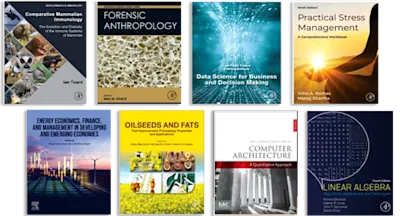
Complementary and Alternative Medicine in Rehabilitation
- 1st Edition - September 6, 2002
- Imprint: Churchill Livingstone
- Author: Eric Leskowitz
- Language: English
Complementary and Alternative Medicine in Rehabilitation is a comprehensive review of currently available scientific information relating to complementary and alternative therap… Read more
Purchase options

Complementary and Alternative Medicine in Rehabilitation is a comprehensive review of currently available scientific information relating to complementary and alternative therapies and rehabilitation. It outlines the current state of knowledge in the area of CAM as it relates to rehabilitation. Rehabilitation involves the practice of a multidimensional form of medicine that encompasses all levels of the human being as patient-body, mind, and spirit. The theory behind rehabilitation is to utilize several forms of therapies in order to heal the body. This integration of therapies is one of the core beliefs of CAM and is why CAM meshes so naturally with rehabilitation.
Representative therapies from each of the following four main categories comprise the first four sections of the book: mind/body therapies (i.e., meditation, biofeedback), body-oriented therapies (i.e., chiropractic, yoga), energy-based therapies (i.e., acupuncture, energy healing), and the emergent approaches (i.e., shamanic healing, teamwork and group dynamics). The emphasis is on evidence-based medicine, with enough research cited to whet the reader's appetite for further study. While history and theory of these CAM approaches are touched upon, the chapters are anchored in clinical examples so that the reader can apply the information to his or her practice.
The second section of the book deals with some of the most widely encountered clinical conditions in rehabilitation, including cardiac and dementia. Emphasis here is on clinical practice, with a solid research base. The Research Springboards section outlines future opportunities in which CAM can be integrated with rehabilitation, such as phantom limb pain and therapeutic touch. And the last section, The Patient's Perspective, tells the stories of a manual laborer, a freelance professional, and a spiritual teacher who have all been exposed to various holistic practices during their rehabilitation processes.
Training resources at the end of each chapter give the reader the opportunity to take the next step in pursuing personal exposure to a modality or approach within his or her own field of medicine.
Representative therapies from each of the following four main categories comprise the first four sections of the book: mind/body therapies (i.e., meditation, biofeedback), body-oriented therapies (i.e., chiropractic, yoga), energy-based therapies (i.e., acupuncture, energy healing), and the emergent approaches (i.e., shamanic healing, teamwork and group dynamics). The emphasis is on evidence-based medicine, with enough research cited to whet the reader's appetite for further study. While history and theory of these CAM approaches are touched upon, the chapters are anchored in clinical examples so that the reader can apply the information to his or her practice.
The second section of the book deals with some of the most widely encountered clinical conditions in rehabilitation, including cardiac and dementia. Emphasis here is on clinical practice, with a solid research base. The Research Springboards section outlines future opportunities in which CAM can be integrated with rehabilitation, such as phantom limb pain and therapeutic touch. And the last section, The Patient's Perspective, tells the stories of a manual laborer, a freelance professional, and a spiritual teacher who have all been exposed to various holistic practices during their rehabilitation processes.
Training resources at the end of each chapter give the reader the opportunity to take the next step in pursuing personal exposure to a modality or approach within his or her own field of medicine.
Medical students, medical doctors, rehabilitation specialists, mental health clinicians, CAM practitioners and students, registered nurses, chiropractors, osteopaths and manual therapists.
Forward: Mindfulness: The Heart of Rehabilitation. Introduction and Overview.
Section I: Techniques
Mind/Body Hypnosis. Meditation. Biofeedback. Psychotherapy. Placebo Factors
Section II: Body-Oriented Therapies
Craniosacral Therapy. Chiropractic. Massage. Feldenkrais. Nutraceutical Medicine. Exercise. Yoga. Tai Chi
Section III: Energy-based Therapies
Acupuncture. Homeopathy. Electromagnetic Therapies. Energy Healing. Qi Gong. Meridian-based Psychotherapy
Section IV: Emergent Approaches
Shamanic Therapy. Spirituality and Rehabilitation. Nature as Healer. Holistic Nursing. Teamwork and Group Dynamics in Rehabilitation
Section V: Specific Rehabilitation Conditions
Cardiac Rehabilitation. Cancer Rehabilitation. Addictions (Acupuncture). Addictions (Spirituality). Dementia. Chronic Depression. Rheumatology
Section VI: Research Springboards
Magnets and Fibromyalgia. EEG Biofeedback and Substance Abuse. Photo-acupuncture and carpal tunnel syndrome. Reiki and Paraplegia. Intercessory Prayer and Alcoholism. Phantom Limb Pain and Therapeutic Touch. Imbalance in the Elderly and Tai Chi
Section VII: The Patient's Perspective
Cervicogenic Vertigo. Brachial Plexopathy. Licensure and Insurance in CAM
Afterward - Eric Leskowitz, MD
Section I: Techniques
Mind/Body Hypnosis. Meditation. Biofeedback. Psychotherapy. Placebo Factors
Section II: Body-Oriented Therapies
Craniosacral Therapy. Chiropractic. Massage. Feldenkrais. Nutraceutical Medicine. Exercise. Yoga. Tai Chi
Section III: Energy-based Therapies
Acupuncture. Homeopathy. Electromagnetic Therapies. Energy Healing. Qi Gong. Meridian-based Psychotherapy
Section IV: Emergent Approaches
Shamanic Therapy. Spirituality and Rehabilitation. Nature as Healer. Holistic Nursing. Teamwork and Group Dynamics in Rehabilitation
Section V: Specific Rehabilitation Conditions
Cardiac Rehabilitation. Cancer Rehabilitation. Addictions (Acupuncture). Addictions (Spirituality). Dementia. Chronic Depression. Rheumatology
Section VI: Research Springboards
Magnets and Fibromyalgia. EEG Biofeedback and Substance Abuse. Photo-acupuncture and carpal tunnel syndrome. Reiki and Paraplegia. Intercessory Prayer and Alcoholism. Phantom Limb Pain and Therapeutic Touch. Imbalance in the Elderly and Tai Chi
Section VII: The Patient's Perspective
Cervicogenic Vertigo. Brachial Plexopathy. Licensure and Insurance in CAM
Afterward - Eric Leskowitz, MD
- Edition: 1
- Published: September 6, 2002
- Imprint: Churchill Livingstone
- Language: English
EL
Eric Leskowitz
Affiliations and expertise
Staff Psychiatrist, Pain Management Program, Spaulding Rehabilitation Hospital; Instructor, Department of Psychiatry Harvard Medical School; Senior Clinical Instructor Department of Psychiatry Tufts University School of Medicine Boston, MA